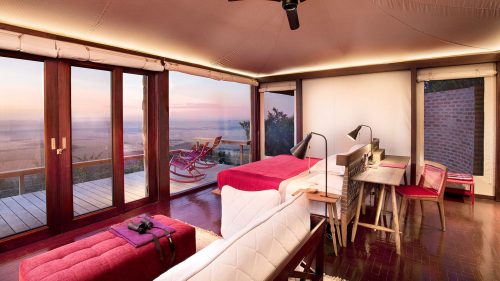On the first week of opening Angama Amboseli, it feels surreal to see this brand-new safari lodge spring to life as the sounds of many months of construction fade away, welcoming our first guests with the calm that this place brings.
Angama Amboseli is located in a private wildlife sanctuary, at the foothills of the world's tallest free-standing mountain, Mount Kilimanjaro. Called Kimana Sanctuary, it is part of a crucial elephant migratory corridor connecting Amboseli, Chyulu Hills and Tsavo West wildlife ecosystems. The landscape is dominated by beautiful fever trees and acacia trees and the views of the mountain from every corner are not too shabby either. This week, the 'shy mountain' was on her best behaviour as she made an appearance every day — almost as if she knew we were preparing for a grand opening.
While out on a walking safari, we watched as vervet monkeys were avidly grooming each other and fortunate to come across a leopard-tortoise strolling along with us on our path. Being one of the slowest animals on land, we had ample time to admire the scaled creature. Tortoises are omnivorous and you will often find them eating plants, insects and slugs.
As a photographer, what I appreciate most about Kimana Sanctuary is its picturesque nature and the abundance of great light. From the beautiful golden sunrises to the occasionally snow-capped Kili and, of course, the sunsets are truly magical as they illuminate the beauty of this landscape.
A short 45-minute drive to Amboseli National Park opens up another fascinating ecosystem, which is a home to the world-renowned Super Tuskers, elephants with tusks so large they sometimes drag along the ground as they walk. Many safari experiences are magical, while others are truly life-changing —when these elephants pass by your safari vehicle you genuinely feel their majesty and are left in awe of nature at its best.
We were lucky enough to spot TJ, one of the bigger tuskers in Amboseli currently. About 35 years old, he comes from a line of Super Tuskers and is the nephew of the late Tim, a famed tusker from this area. TJ has great potential to become one of the massive elephant Super Tuskers. Our eyes (and our cameras) will be on the lookout to capture the priceless stories of this fascinating new landscape. – Sammy Njoroge
As the sun crept over the horizon, we stumbled upon a solitary lioness, deeply engrossed in digging. The lioness, with her sinewy muscles and sharp eyes, was a picture of focused determination. She was tirelessly working to excavate the stubborn ground to get the animal trapped inside. After a while, she rested beside the hole, tending to an injured paw, a testament to the battle she had been waging. The formidable opponent finally revealed itself — a sizable warthog, its gaze fixed on the looming threat.
In a flash, the warthog's frantic squeals pierced the air as the lioness clamped down on its nape. A desperate struggle followed with the lioness aiming for its throat. Though the warthog fought valiantly, it was ultimately overpowered by the relentless predator.
Success in the wild doesn't always guarantee possession as vigilant eyes and ears abound. The most arduous task still lay ahead: safeguarding the spoils from competitors. The warthog's cries drew the attention of three young male lions from a considerable distance. Enticed by the promise of an easy feast, they charged towards the outnumbered lioness. Faced with such formidable opposition, she reluctantly relinquished her hard-earned prize to the intruders.
The Angama lioness continues to impress us as she successfully brought down another zebra in close proximity to Angama Mara. This is such a noteworthy feat, as hunting alone is not typical behaviour for lions, who are inherently social creatures and learn to hunt this way. Zebras, known for their resilience, also don't easily succumb to the threat of death and can land fatal blows of their own with a well-placed kick. The fact that this solitary lioness consistently makes successful zebra hunts attests to her remarkable strength and tactical prowess. Then again, she is related to the late Mama Kali, the fiercest lioness we have seen.
Given the size and weight of the kill, it proved impossible to drag her spoils away from potential scavengers. She began by consuming the softer internal organs before returning to feed her two concealed cubs. The Angama lioness is especially shy and we believe this is influenced by the tragic events that led to the loss of her pride and left her to fend for herself. – Robert Sayialel
Filed under: This Week at Angama
Subscribe for Weekly Stories
Comments (2):
7 November 2023
Question, what is The lioness related to Mama Kali’s Name ? Mama Kali was something special 🙏🏽💜

Tented Suites